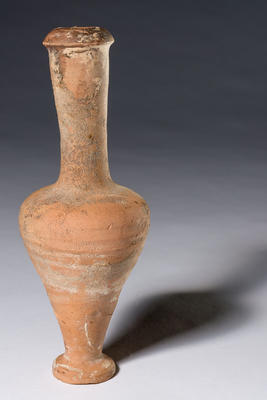Vessel, Unguentarium
Production date
Circa 2nd Century BCE
Country
Cyprus
See full details
Object detail
Description
Unguentarium. Domed mouth type. Conidal body with well-marked shoulder. Tall narrow cylindrical neck widening to thickened domed mouth. Low foot with heavy flat base. Band of wheel-ridging on body. Surface scarred and scraped before firing. Orange brown clay with dark, slightly lustrous red to black slip coating on rim, dribbled onto upper neck on interior and exterior with small splashes on body. Base chipped. Some surface encrustation (Webb, Jennifer M., "Corpus of Cypriote Antiquities", Studies in Mediterranean Archaeology, Vol. XX: p 12.)
Classification
ARCHAEOLOGY Cypriot flask
Production date
Circa 2nd Century BCE
Production place
Measurements
L197mm x W73mm x D73mm
Media/Materials description
Pottery, orange brown clay with dark slightly lustrous red to black slip coating on rim, dribbled onto upper neck on interior and exterior with small splashes on body.
Signature/Marks
decoration
manufacture
manufacture
History and use
Pottery is one of the most abundant, common and enduring artefacts in the ancient record, and one of human kinds most fundamental technologies. The craft or making pottery was widespread throughout the ancient world. Pottery was widespread as it was cheap to make, malleable into various forms and watertight after firing. Potters learnt the craft over several years – digging local clay, removing stones and roots, passing it through mesh, mixing with water and settling, cutting into squares, kneading to remove air pockets, forming the vessel, and firing. Vessels can be made using various methods, including pinch, coil, slab, paddle and anvil, and wheel or mould. It can be relatively plain, or decorated by using impressed designs, slips, paints, and even applying mould-made figures. Plain ware vessels are often under-reported in comparison to the more highly decorated vessels. Domestic pottery changed little in form and was largely undecorated – reflecting the ‘form and function’ approach and everyday utility of these vessels. This unguentarium is distinctly Cypriote in style although several have been found outside the island. They were used to hold ointments, perfumes, balms and other liquids for use in the toilet.
Associated person
Registration number
H650



